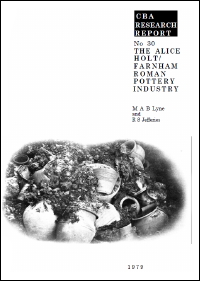CBA Research Reports
Council for British Archaeology, 2000. (updated 2020) https://doi.org/10.5284/1000332. How to cite using this DOI
Data copyright © Council for British Archaeology unless otherwise stated
This work is licensed under the ADS Terms of Use and Access.
Primary contact
Council for British Archaeology
92 Micklegate
York
YO1 6JX
UK
Tel: 01904 671417
Resource identifiers
- ADS Collection: 281
- DOI:https://doi.org/10.5284/1000332
- How to cite using this DOI
The Alice Holt/Farnham Roman pottery industry
M A B Lyne and R S Jefferies
CBA Research Report No 30 (1979)
ISBN 0 900312 66 1
Abstract

The Alice Holt/Farnham potters produced coarse, grey, kitchen wares on the Hampshire - Surrey border along the upper reaches of the headwater streams of the river Wey. The production centres so far known were at Farnham on the northern Wey, at Malthouse Farm, Kingsley, at Alice Holt and Baigents Bridge, Headley on the southern Wey, and at Tilford at the confluence of the two streams. Large-scale production took place from about AD 60 to the 5th century, but this may have been preceded by works on a smaller scale in the Iron Age and Claudian periods. Production reached its peak during the mid-late 4th ccntury when this industry dominated the London market and orhers in the south-east.
Contents
- Title pages
- Introduction (pp 1-2)
- The pottery-manufacturing kiln groups (pp 3-11)
- The Alice Holt group (pp 3-9)
- Location (Fig 1) (pp 3-4)
- Schedule of waster dumps in the Alice Holt kiln group (pp 5-9)
- The Malthouse Farm Group (pp 9-10)
- Location (Fig 4) (pp 9-10)
- Schedule of sites in the Malthouse Farm kiln group (p 10)
- The Baigent's Bridge kiln group (p 10)
- The Tilford group (p 10)
- The Farnham Group (p 11)
- Location (Fig 1) (p 11)
- Schedule of sites in the Farnham kiln group (p 11)
- The Alice Holt group (pp 3-9)
- Raw materials, organization, and technology (pp 12-19)
- Raw materials and the evidence for their exploitation (pp 12-13)
- Clay, Sand, Turves, Fuel (pp 12-13)
- Internal organization and levels of production (pp 13-14)
- The contemporary landscape (Fig 4) (pp 14-17)
- Technology (pp 17-19)
- Raw materials and the evidence for their exploitation (pp 12-13)
- The corpus of pottery types; the origins of the industry (pp 20-33)
- Class 1: Cordoned jars (Figs 6 and 7) (pp 20-24)
- Class lA: Cordoned and necked jars (Fig 9) (pp 24-25)
- Class 2: Jars with pedestals (Fig 10) (p 25)
- Class 3: Devolved butt beakers (Fig 11) (p 25)
- Class 3A: Flat-rimmed jars (Fig 12) (pp 25-27)
- Class 3B: Everted-rim jars (Fig 14) (pp 27-28)
- Class 4: Head-rimmed jars (Fig 15) (pp 28-31)
- Class 5: Bowls (Fig 17) (p 31)
- Class 6: Dish/lids imitating Crallo-Helgic forms (Fig 18) (pp 31-33)
- Class 7: Iids (Fig 19) (p 33)
- Class 8: Single- and double-handled flagons (Fig 20) (p 33)
- Class 9: Hand-made storage jars (Fig 21) (p 33)
- The corpus of pottery types: the later industry (pp 34-51)
- Class 1: Cordoned jars (Fig 22) (p 41)
- Class 1A: Cordoned and necked jars (Fig 23) (p 41)
- Class 1B: Flasks (Fig 24) (p 41)
- Class 1C: Iarge cordoned storage jars (Fig 25) (p 41)
- Class 2: Jars with pedestals (Fig 26) (p 41)
- C:lass 3A: Flat-rimmed jars (Fig 27) (p 42)
- Class 3B: Everted and 'cavetto' rimmed jars (Fig 28) (p 42)
- Class 3C: Triangular- and hooked-rim jars (Fig 29) (p 45)
- Class 4: Bead-rimmed jars (Fig 30) (p 45)
- Class 5A: Flat- and triangular-rimmed bowls (Fig 31) (p 45)
- Class 5B: Headed and flanged bowls (Fig 32) (p 46)
- Class 5C: Strainers (Fig 33) (p 46)
- Class 5D: Deep decorated bowls (Fig 34) (p 47)
- Class 5F: Iarge reeded-rimmed bowls (Fig 35) (p 47)
- Class 6A: Straight- and convex-sided dishes (Fig 36) (p 48)
- Class 6B: Flat- and triangular-rimmed dishes (Fig 37) (p 50)
- Class 6C: Beaded and flanged dishes (Fig 38) (p 50)
- Class 7: Lids (Fig 39) (p 50)
- Class 8: Flagons (Fig 40) (p 51)
- Class 10: Large cable-rimmed vessels (Fig 41) (p 51)
- The distribution of Alice Holt/Farnham ware (pp 52-61)
- The late 1st and early 2nd centuries (Figs 42-44) (pp 52-54)
- The late 2nd and early 3rd centuries (Figs 45 and 46) (pp 54-56)
- The late 3rd and early 4th centuries (Figs 47-49) (pp 56-58)
- The late 4th century (Figs 50 and 51) (pp 58-61)
- Alice Holt pottery from continental sites (Information supplied by Dr M C Fulford) (p 61)
- Acknowledgements (p 62)
- Appendix 1: Charcoal samples from Dump AH 5, Pit B. 1 (J E Pratt) (p 62)
- Appendix 2: Determination of the firing temperature of sherds from the Alice Holt Romano-British potteries using the thermal expansion method (J G Rider and M Roberts) (pp 63-65)
- Appendix 3: Percentages of Alice Holt/Farnham ware from various occupation sites (pp 66)
- Appendix 4: Gazetteer of sites with Alice Holt/Farnham ware of corpus types covered by the distribution maps in the text (pp 67-74)
- Appendix 5: List of museums, units, societies, and individuals holding collections of material examined (p 75)
- Bibliography (p 76)
- Notes (p 77)
Download report
| The Alice Holt/Farnham Roman pottery industry (CBA Research Report 30) | 7 Mb |







